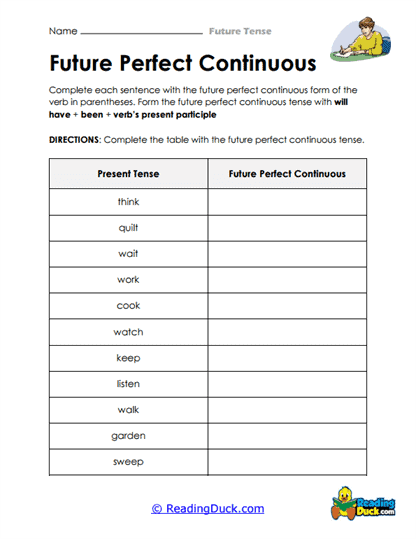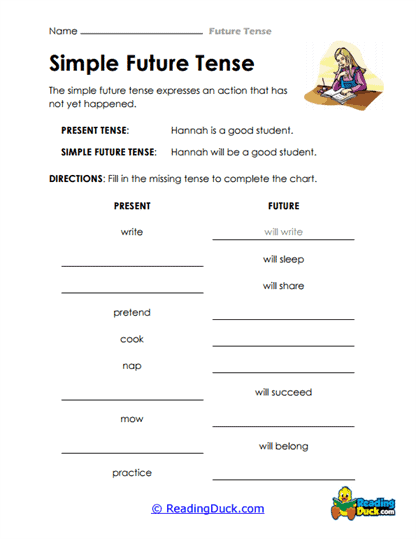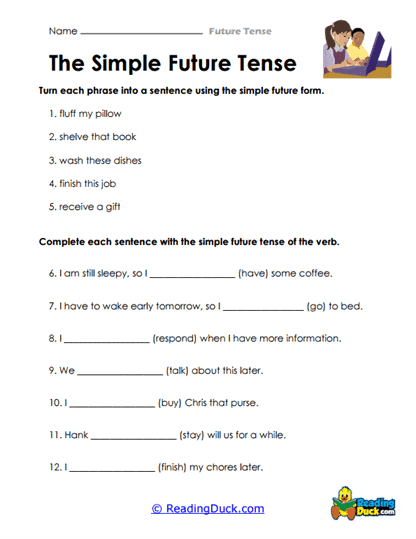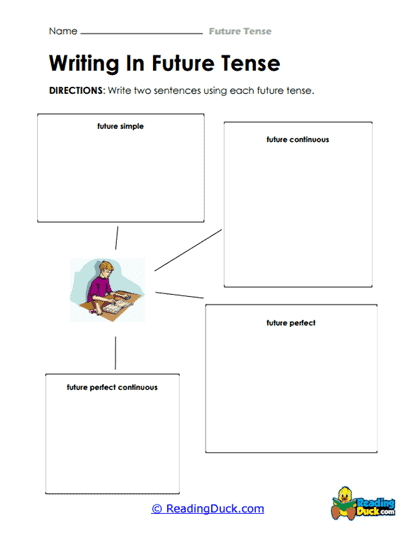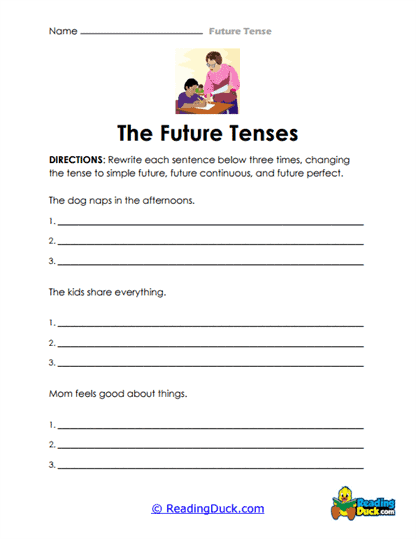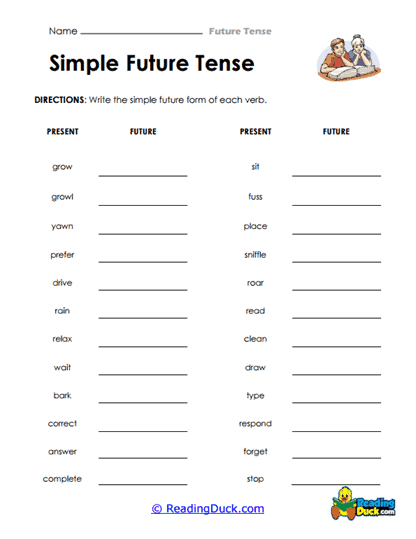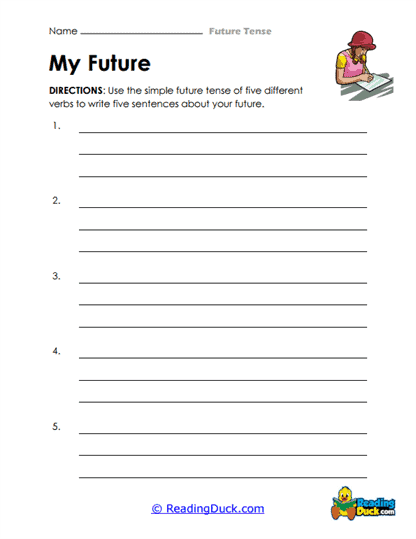Future Tense Worksheets
About Our Future Tense Worksheets
Our Future Tense Worksheets provide students with comprehensive and engaging exercises designed to build mastery in the use of future tense in English. Falling under the Grammar category within the Skills section, these worksheets help students understand how to express actions or events that will take place in the future. Whether students are learning to form basic future tense sentences or exploring more advanced structures, this collection is structured to meet a range of learning levels.
Through step-by-step explanations and diverse activities, students can develop confidence in recognizing and using the future tense in everyday communication. These worksheets guide learners through various forms of the future tense, such as the will form, the going to form, and the use of future continuous and future perfect. The worksheets are available in PDF format, making them simple to view, download, and print for use in class or at home. Additionally, each worksheet includes a downloadable answer key, making it easy for teachers and students to track progress and correct errors efficiently.
Exploring Future Tense: A Thorough Understanding
The future tense is a grammatical structure used to express actions or events that have not yet occurred but are expected to happen in the future. Understanding how to form and use the future tense is essential for clear communication, as it allows speakers and writers to convey plans, predictions, or expectations.
What is Future Tense?
The future tense refers to any verb tense that indicates an action or event will take place after the present moment. There are several ways to express the future tense in English, each with its own nuance and usage.
Types of Future Tense
Simple Future Tense (Will + Base Form of the Verb):
-
- The simple future tense is formed by using will followed by the base form of the verb. This form is used to express future actions that are decided at the moment of speaking or predictions about the future.
- Example: "I will call you tomorrow."
- Usage: This structure is commonly used to make promises, predictions, and spontaneous decisions.
Be Going to + Base Form of the Verb:
-
- The going to form is used to express intentions or plans that have already been made, as well as to make predictions based on current evidence.
- Example: "They are going to move to a new house next month."
- Usage: This form is often used when talking about planned events or outcomes that seem inevitable based on current circumstances.
Future Continuous (Will + Be + Present Participle):
-
- The future continuous tense describes actions that will be ongoing at a specific point in the future.
- Example: "She will be traveling to Paris this time next week."
- Usage: This tense is used when we want to emphasize that an action will be in progress at a future time.
Future Perfect (Will + Have + Past Participle):
-
- The future perfect tense is used to describe actions that will be completed before a certain point in the future.
- Example: "By next year, he will have finished his degree."
- Usage: This tense helps to talk about the completion of tasks or events before a future deadline.
Future Perfect Continuous (Will + Have Been + Present Participle):
-
- This form expresses actions that will continue until a specific future time and will have been ongoing for a certain period.
- Example: "By 5 p.m., I will have been working for eight hours."
- Usage: It highlights the duration of an ongoing action before another future event.
Techniques to Introduce Future Tense to Students
Introducing the future tense requires a structured approach to help students grasp how to express future events in various contexts. Educators can employ several strategies to make learning the future tense engaging and effective.
Use Timelines for Clarity: Begin with a visual aid, such as a timeline, to show the relationship between the present and future. Mark the present time on the timeline and use arrows to indicate when future actions will occur. This helps students visualize how the future tense operates in relation to other tenses.
-
- Example: Use a timeline to illustrate how "I will travel" refers to an action that will happen after the present moment.
Teach the Forms Step-by-Step: Introduce each future tense form one at a time, beginning with the simple future (will + verb) and then moving on to more complex forms like future continuous and future perfect. Provide plenty of examples to illustrate the different uses.
-
- Tip: Reinforce each form with exercises that focus specifically on that structure, helping students internalize the pattern before moving on.
Encourage Predictive Statements: Ask students to make predictions about everyday life or world events using the future tense. This engages their critical thinking while practicing the future tense in a fun way.
-
- Example: Have students predict the weather for the next day or make predictions about technology advancements in the coming years.
Role-Playing for Planning: Role-playing activities can help students practice the future tense, particularly the going to form. Create scenarios where students must discuss future plans or intentions with each other, such as planning a vacation or organizing an event.
-
- Example: One student can ask, "What are you going to do this weekend?" while the other responds, "I am going to visit my grandparents."
By breaking down the topic and using these techniques, educators can ensure that students understand the various ways to express future actions clearly and effectively.
Addressing Common Challenges with Future Tense
Learning the future tense can present challenges, especially when students are trying to differentiate between the different forms of future tense and their uses. Addressing these challenges head-on can prevent confusion and reinforce understanding.
Challenge: Confusing "Will" and "Going To":
-
- One of the most common difficulties students face is knowing when to use will versus going to. They may use these forms interchangeably without understanding the specific contexts for each.
- Strategy: Provide students with clear examples and explanations of when to use will (for spontaneous decisions and predictions) and going to (for planned actions or predictions based on evidence). Practice exercises that focus on choosing between these forms can help clarify their differences.
Challenge: Overusing Simple Future Tense:
-
- Many students overuse the simple future tense because it is the easiest to form. They may default to using will for all future expressions, even when other forms would be more appropriate.
- Strategy: Encourage variety by introducing context-specific tasks that require the use of future continuous or future perfect. For example, ask students to describe what they will be doing at a certain time in the future or what they will have accomplished by a future deadline.
Challenge: Misunderstanding Future Perfect:
-
- The future perfect tense can be particularly challenging because students must think about two future points in time—the action and its completion. This can lead to confusion about when to use this tense.
- Strategy: Teach future perfect with clear timelines and practice scenarios that show how one event will be completed before another. Reinforce this by asking students to describe tasks they will have finished by the end of the week or year.
By identifying these common challenges and providing targeted solutions, students will better understand the nuances of future tense and improve their grammar skills.
Interactive Activities to Reinforce Future Tense Concepts
Interactive activities offer an engaging way to reinforce the future tense and make learning more enjoyable. These activities can be adapted for both classroom and homeschool settings, giving students the opportunity to apply their knowledge in fun and practical ways.
- Future Tense Prediction Cards (Grades 2-5): Create a set of cards with various predictions written on them. Students take turns drawing a card and reading the prediction aloud, using the appropriate future tense form. This helps students practice constructing future sentences in different contexts.
- Timeline Project (Grades 3-6): Have students create personal or fictional timelines that show events in the future. For example, they can draw a timeline of their goals for the next year, using sentences like "I will finish this project by March" or "By December, I will have learned to play the guitar."
- Future Tense Story Writing (Grades 4-6): Ask students to write short stories or paragraphs about a day in their life in the future, using various forms of the future tense. Encourage them to use different structures, such as will, going to, and future continuous in their narratives.
- Classroom Predictions (Grades 2-6): At the start of the school year or term, have students make predictions about what will happen by the end of the year. Encourage them to use different future tense forms to express their predictions, such as "By the end of the year, I will have improved my reading skills."
These activities encourage creativity while allowing students to practice the future tense in engaging and interactive ways.
The Value of Mastering Future Tense for Students
Learning to use the future tense correctly is an essential skill for students, as it allows them to express plans, predictions, and intentions clearly and accurately. The ability to talk about future events is necessary for effective communication in both everyday situations and academic contexts.
Mastering the future tense enhances a student's ability to write, speak, and think critically about time and actions that have not yet occurred. It also prepares students for more complex grammar structures and enables them to convey more detailed and nuanced ideas. Whether in casual conversation, writing essays, or making presentations, a strong grasp of future tense helps students articulate their thoughts with clarity and precision.
By using our Future Tense Worksheets, students will gain a solid foundation in future tense forms, preparing them to use this aspect of grammar confidently in real-life situations.
